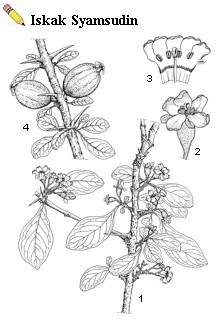Record Number
2465
PROSEA Handbook Number
12(3): Medicinal and poisonous plants 3
Taxon
Catunaregam spinosa (Thunberg) Tirveng.
This article should be read together with the article on the genus: Catunaregam in the Handbook volume indicated above in this database.
This article should be read together with the article on the genus: Catunaregam in the Handbook volume indicated above in this database.
Protologue
Bull. Mus. Nation. Hist. Nat., 3e sér., no. 521, Bot. 35: 13 (1978).
Synonyms
Randia dumetorum (Retz.) Poir. (1811), Randia spinosa (Thunberg) Blume (1826), Xeromphis spinosa (Thunberg) Keay (1958).
Vernacular Names
Laos: may ngieng pa. Thailand: khet khaang (Chanthaburi), khlet (Ratchaburi), ma khwet (northern). Vietnam: g[aw]ng tu h[us], g[aw]ng tr[aa]u.
Distribution
Eastern and southern Africa, Nepal, India, Sri Lanka, Indo-China, Thailand and Java (rare).
Uses
In Indo-China, powdered and roasted fruits (without seeds) are used externally to treat ulcers, and the bark is used internally against diarrhoea and dysentery and to regulate menses. In India, the bark is used to treat diarrhoea and dysentery; the plant is also used there in traditional medicine to treat bronchitis, asthma, leucoderma and diseases of the brain, and the fruit pulp for poulticing sores. In Africa, Catunaregam spinosa is a much used medicinal plant. A decoction of the powdered root is applied directly on melanomas, and the infusion is administered orally as an emetic and to relieve fever, nausea, general coughs, toothache, pains during pregnancy, dizziness, menorrhagia, depressed fontanelle, snakebites and gonorrhoea. The fruits are used as a substitute for soap. Bark and fruits are used in India, Nepal and Africa as a fish poison. In Indo-China, it is often planted in fences, whereas the wood is commonly used in India as fuelwood.
Observations
A spiny, much-branched large shrub or small tree up to 7.5 m tall; leaves glabrous or pubescent on veins only; flowers 5(—8)-merous, white becoming yellowish; fruit ellipsoid to globose, 2—3.5 cm long, yellowish. Catunaregam spinosa occurs on dry, bare soils, also on the beach.
Image
 | Catunaregam spinosa (Thunberg) Tirveng. - 1, flowering branch; 2, flower; 3, opened corolla with stamens, style and stigma; 4, fruiting branch |
Selected Sources
[62]Backer, C.A. & Bakhuizen van den Brink Jr, R.C., 1964—1968. Flora of Java. 3 volumes. Noordhoff, Groningen, the Netherlands. Vol. 1 (1964) 647 pp., Vol. 2 (1965) 641 pp., Vol. 3 (1968) 761 pp.
[121]Burkill, I.H., 1966. A dictionary of the economic products of the Malay Peninsula. Revised reprint. 2 volumes. Ministry of Agriculture and Co- operatives, Kuala Lumpur, Malaysia. Vol. 1 (A—H) pp. 1—1240, Vol. 2 (I— Z) pp. 1241—2444.
[224]Dubois, M.A., Benze, S. & Wagner, H., 1990. New biologically active triterpene-saponins from Randia dumetorum. Planta Medica 56(5): 451—455.
[650]Mukherjee, K.S., Mehrotra, A., Bhattacharjee, P., Laha, S. & Chakraborty, C.K., 1991. A new diol from Randia longispina. Fitoterapia 62(6): 506—507.
[665]Nandy, A.C. & Chakrabarty, D.P., 1976. A note on the use of unripe fruits of Randia dumetorum Lam. as a fish poison. Journal of the Inland Fisheries Society of India 8: 134—136.
[671]Nguyen Van Duong, 1993. Medicinal plants of Vietnam, Cambodia and Laos. Mekong Printing, Santa Ana, California, United States. 528 pp.
[810]Saluja, A.K. & Santani, D.D., 1984. Antifertility activity of Xeromphis spinosa and Annona squamosa. Indian Journal of Pharmaceutical Sciences 46(1): 21—23.
[822]Sati, O.P., Chaukiyal, D.C., Nishi, M., Miyahara, K. & Kawasaki, T., 1986. An iridoid from Randia dumetorum. Phytochemistry 25(11): 2658—2660.
[823]Sati, O.P., Rana, U., Chaukiyal, D.C., Madhusudanan, K.P. & Bhakuni, D.S., 1987. Molluscicidal triterpenoidal glycosides of Xeromphis spinosa. Planta Medica 53(6): 530—532.
[852]Sibanda, S., Ndengu, B., Multari, G., Pompi, V. & Galeffi, C., 1989. A coumarin glucoside from Xeromphis obovata. Phytochemistry 28(5): 1550—1552.
[884]Sotheeswaran, S., Bokel, M. & Kraus, W., 1989. A hemolytic saponin, randianin, from Randia dumetorum. Phytochemistry 28(5): 1544—1546.
[121]Burkill, I.H., 1966. A dictionary of the economic products of the Malay Peninsula. Revised reprint. 2 volumes. Ministry of Agriculture and Co- operatives, Kuala Lumpur, Malaysia. Vol. 1 (A—H) pp. 1—1240, Vol. 2 (I— Z) pp. 1241—2444.
[224]Dubois, M.A., Benze, S. & Wagner, H., 1990. New biologically active triterpene-saponins from Randia dumetorum. Planta Medica 56(5): 451—455.
[650]Mukherjee, K.S., Mehrotra, A., Bhattacharjee, P., Laha, S. & Chakraborty, C.K., 1991. A new diol from Randia longispina. Fitoterapia 62(6): 506—507.
[665]Nandy, A.C. & Chakrabarty, D.P., 1976. A note on the use of unripe fruits of Randia dumetorum Lam. as a fish poison. Journal of the Inland Fisheries Society of India 8: 134—136.
[671]Nguyen Van Duong, 1993. Medicinal plants of Vietnam, Cambodia and Laos. Mekong Printing, Santa Ana, California, United States. 528 pp.
[810]Saluja, A.K. & Santani, D.D., 1984. Antifertility activity of Xeromphis spinosa and Annona squamosa. Indian Journal of Pharmaceutical Sciences 46(1): 21—23.
[822]Sati, O.P., Chaukiyal, D.C., Nishi, M., Miyahara, K. & Kawasaki, T., 1986. An iridoid from Randia dumetorum. Phytochemistry 25(11): 2658—2660.
[823]Sati, O.P., Rana, U., Chaukiyal, D.C., Madhusudanan, K.P. & Bhakuni, D.S., 1987. Molluscicidal triterpenoidal glycosides of Xeromphis spinosa. Planta Medica 53(6): 530—532.
[852]Sibanda, S., Ndengu, B., Multari, G., Pompi, V. & Galeffi, C., 1989. A coumarin glucoside from Xeromphis obovata. Phytochemistry 28(5): 1550—1552.
[884]Sotheeswaran, S., Bokel, M. & Kraus, W., 1989. A hemolytic saponin, randianin, from Randia dumetorum. Phytochemistry 28(5): 1544—1546.
Author(s)
R.H.M.J. Lemmens
Correct Citation of this Article
Lemmens, R.H.M.J., 2003. Catunaregam spinosa (Thunberg) Tirveng.. In: Lemmens, R.H.M.J. and Bunyapraphatsara, N. (Editors): Plant Resources of South-East Asia No 12(3): Medicinal and poisonous plants 3. PROSEA Foundation, Bogor, Indonesia. Database record: prota4u.org/prosea

All texts are licensed under a Creative Commons Attribution-Noncommercial-Share Alike 3.0 Netherlands License
This license does not include the illustrations (Maps,drawings,pictures); these remain all under copyright.